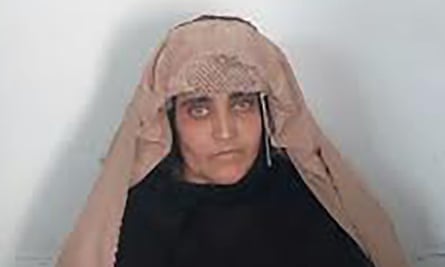An Afghan woman who once appeared on the cover of National Geographic as a green-eyed 12-year-old girl has been arrested for living illegally in Pakistan under false papers.
Last year Pakistani media published a photo from Sharbat Gula’s computerised national identity card (CNIC), a vital document that she should not have been able to acquire as a foreign national.
But it was only on Wednesday that Pakistan’s Federal Investigation Agency arrested her, after a lengthy investigation.

Shahid Ilyas, an official from the National Database Registration Authority, said Gula could face up to 14 years in prison and a fine of up to $5,000 if convicted. He said the FIA was also trying to catch the three Nadra officers thought to have been responsible for giving her the ID card in April 2014.
The National Geographic cover photo of Gula was taken by Steve McCurry in 1984 in a refugee camp in Pakistan. It became one of the defining images of a conflict between mujahideen insurgents and Soviet occupying forces.
Millions of people were displaced by the conflict and many chose never to return, establishing businesses and starting families in Pakistan. Today the country has an Afghan refugee population of 2.5 million. But Afghans have become increasingly unwelcome, with politicians often blaming the refugee community for crime and terrorism.
The massacre by Pakistani Taliban gunmen of more than 130 schoolboys in Peshawar in 2014 prompted the government to commit to a “national action plan” to repatriate all refugees, even though no Afghans were found to have been involved in the attack.
Gula is just one of many Afghans to be caught up in the ongoing effort to persuade refugees to go home. Nadra says it has detected 60,675 cards that were fraudulently obtained by foreign nationals.
It emerged in May that the former Taliban leader Mullah Akhtar Mansoor had been travelling around the country on fake Pakistani documents before he was killed in a US drone strike.
This year has seen a surge in the number of Afghans leaving Pakistan, after a government crackdown and an increase in financial assistance from the UN to refugees who return to Afghanistan.
More than 350,000 refugees have returned this year, according to the UN. The inflow is adding to pressure on Afghanistan’s already hard-pressed government. Many of the arrivals are younger Afghans who were born in Pakistan and have never before been to Afghanistan.
In Pakistan, bank and mobile phone accounts of Afghans without the correct documents have been shut down, and there have been widespread complaints about official harassment and the police using the crackdown as an opportunity to extort cash from refugees.
Since 2009, Islamabad has repeatedly pushed back a deadline for refugees to return, but fears are growing that the latest deadline of March 2017 will be final.




